Rescuing reds is nuts! A tail of squirrel conservation
Lucie Debaig pours cold water on red squirrel conservation efforts and suggests making peace with greedy greys

Despite being classified as a species of least concern on the IUCN red list, the UK consistently pours money and effort into protecting the Eurasian red squirrel, Sciurus vulgaris. You may wonder quite how much is spent. Precise numbers are difficult to determine, but one clear indicator is that Save Our Squirrels UK received £1.2 million to cover three years of conservation efforts in 2007. Considering the plethora of independent red squirrel charities in the UK and their various funding bodies, the budget to save this elusive species must be astronomical. Determined efforts continue today, as illustrated by The England Red Squirrel Action Plan (ERSAP) 2023-2028 which came into effect on the 21st of January 2023, officially Red Squirrel Appreciation Day.
Although red squirrels have many strongholds in other areas of Europe, these conservation efforts are justified by the irrefutable and recent decline in red squirrel populations in the UK. This, to a greater extent than most declines in biodiversity, is clearly due to human interference. The beginning of the end for these enigmatic creatures can be dated to 1876, when grey squirrels were first officially released in the UK as a banker’s ornamental curiosity in Henbury Park, Cheshire. In typical Victorian fashion, these frivolous decisions were made without regard for ecology, but, to give credit where credit is due, without malice: no one was to know the extensive consequences of adopting these exotic pets.
With the benefit of hindsight, we now know that grey squirrels carried a foreign virus, squirrel pox, against which reds had not developed immunity. While grey squirrels are asymptomatic, an afflicted red squirrel may experience lethargy, swelling, and ulcers around the eyes, nose, mouth, and paws. Usually, this is fatal. Above all other reasons, this virus is why reds and greys cannot coexist: grey squirrels carry an anti-red bioweapon. Furthermore, greys are larger, outcompeting reds for food and other resources, and typically live at higher population densities, making them a more reproductively successful species.
“Above all other reasons, this virus is why reds and greys cannot coexist: grey squirrels carry an anti-red bioweapon”
According to the Scottish Wildlife Trust and other charities, this replacement of reds with greys should be resisted. Let us work critically through their three pillars of reasoning: socioeconomics, culture, and ecology. Firstly, with respect to socio-economic benefits of red squirrels, they cited the benefits of wildlife tourism in Scotland: wildlife watching, across all species, generates £138 million per year for the nation. There is no convincing evidence that red squirrels significantly contribute to this. A simple search of the top wildlife tours in Scotland makes no mention of the red squirrel, instead advertising birds, deer, pine martens, and various sea life to curious tourists.
The asserted cultural importance of red squirrels is also dubious. While Beatrix Potter’s beloved Squirrel Nutkin epitomises the charm many associate with this species, and a few coats of arms use the squirrels to symbolise industriousness, the red squirrel does not nearly approach the British symbolic value of the lion or the unicorn. For any readers not familiar with British wildlife, please be aware that neither lions nor unicorns are particularly commonplace in British landscapes. The symbolic value of an animal is evidently independent of its ecological prevalence.
Finally, ecology. Although reds and greys are similar species, the higher density of grey squirrel populations means that harmful behaviours exhibited by both, such as bark stripping of young trees, are magnified in areas with more greys. This makes trees more vulnerable to fungal and bacterial diseases both in the UK and in Italy, where similar ecological shifts are taking place. However, bark stripping behaviour is neither well characterised nor well understood in either species, and comparative studies appear not to have been done.
“Grey squirrels are not as detrimental to the UK as many believe”
Both species are squirrels. Both strip bark and bury acorns, climb trees, get hunted, reproduce and die. While there may be some merit in rescuing reds if a convincing case can be made for the wellbeing of forests, grey squirrels are not as detrimental to the UK as many believe. Red squirrels are already locally extinct in most of the UK including Cambridgeshire, and Hayley Wood is yet to suffer total ecological collapse. Take this as a calming message: red and grey squirrel population dynamics are quite stable, an elegant example of ecological substitution.
So, what of the funding and effort we are currently pouring into red squirrels? Many other species need protecting to maintain biodiversity, species without a simple ecological replacement. The UK lacks its historical apex predators, such as wolves, and their reintroduction is a contentious topic in need of significantly more research to create realistic legislation for coexistence of humans and carnivores - another drag on our finances. The conversation involves the argument that we should spend this money overseas on more critically endangered species. Or perhaps research into non-chemical pest control and crop fertilisation is our best investment strategy, maintaining our rapidly dwindling insect populations. In any case, let’s not get too nutty about squirrels.
 Comment / Plastic pubs: the problem with Cambridge alehouses 5 January 2026
Comment / Plastic pubs: the problem with Cambridge alehouses 5 January 2026 News / Cambridge academics stand out in King’s 2026 Honours List2 January 2026
News / Cambridge academics stand out in King’s 2026 Honours List2 January 2026 News / Cambridge businesses concerned infrastructure delays will hurt growth5 January 2026
News / Cambridge businesses concerned infrastructure delays will hurt growth5 January 2026 News / AstraZeneca sues for £32 million over faulty construction at Cambridge Campus31 December 2025
News / AstraZeneca sues for £32 million over faulty construction at Cambridge Campus31 December 2025 Interviews / You don’t need to peak at Cambridge, says Robin Harding31 December 2025
Interviews / You don’t need to peak at Cambridge, says Robin Harding31 December 2025










